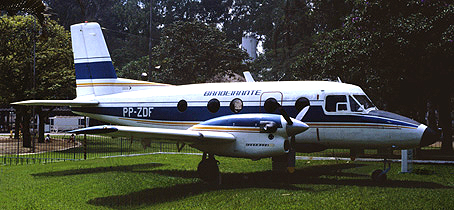
The Italian Aerospace Information Web
by Aeromedia - corso Giambone 46/18 - 10135 Torino (Italy)
Il terzo prototipo dell'YC-95 Bandeirante (modello EMB 100)PP-ZDF esposto nel parco Novo Horizonte di São José dos Campos in Brasile nel novembre 1989. Il Bandeirante deve le sue origini, nella metà degli anni '60, al progetto IPD/PAR-6504 sviluppato dall'IPD/PAR Instituto de Pesquisas e Desenvolvimento / Departamento de Aeronaves (Istituto di Ricerca e Sviluppo / Dipartimento Aeroplani) sotto la responsabilità del famoso progettista francese Max Holste. Inizialmente l'aereo fu concepito come trasporto militare leggero siglato YC-95. I primi due prototipi furono costruiti nelle officine militari del CTA (Centro Técnico de Aeronáutica). Il terzo fu costruito a São José dos Campos nell'embrione della neo costituita Embraer (Empresa Brasileira de Aeronáutica). Il primo YC-95 (numero di serie 2130) volò il 20 ottobre 1968, seguito il 19 ottobre dell'anno successivo dall'esemplare 2131. L'esemplare 2132 illustrato nella foto effettuò il primo volo il 29 giugno 1970 con marche PP-ZCN. Dopo aver contribuito all'attività di certificazione del tipo, esso rimase in attività con l'IMPE (Instituto Pesquisas Especiais) fino al 1976. Il 21 febbraio 1981 fu infine esposto nel parco centrale di São José dos Campos. (Aeromedia)
The third prototype of the Embraer YC-95 Bandeirante (model EMB 110)on display inside the Novo Horizonte park of São José dos Campos (Brazil) in November 1989. The Bandeirante was conceived during the mid-sixties by the IPD/PAR Instituto de Pesquisas e Desenvolvimento / Departamento de Aeronaves (Research and Development Institute / Aircraft Bureau )as project IPD/PAR-6504 under the leadership of Max Holste, the renowned French aircraft engineer. Initially the aircraft was intended as a light military transport coded YC-95. The first two prototypes were built by the CTA (Centro Técnico de Aeronáutica) military facility. The third one was built at São José dos Campos by the newly-established EMBRAER (Empresa Brasileira de Aeronáutica). The first YC-95 (serial number 2130) made its maiden flight on October 20, 1968 and the second one (2131) joined the flight activity on October 19, 1969. Serial number 2132 shown here made its first flight on June 29, 1970 with civil marks PP-ZCN. After a significant contribution to the type certification programme, it remained in service with IMPE (Instituto Pesquisas Especiais) until 1976. Finally, on February 21, 1981, it was placed on display in the central park of São José dos Campos. (Aeromedia)
